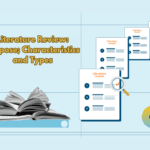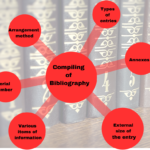Characteristics of a Narrative Literature Review
A narrative literature review is a type of academic writing that gives an overview of what has already been studied about a particular topic. Instead of following strict methods like a systematic review, it is more flexible and descriptive. The main goal is to summarize, interpret, and connect existing research in a way that tells a coherent “story” about how knowledge in the field has developed.
Because of this approach, narrative literature reviews are very useful for providing background information, explaining trends, highlighting key debates, and identifying gaps in research. They are especially helpful for new or broad topics, where different perspectives need to be considered.
To understand how they work, it is important to look at their main characteristics, which show what makes them different from other types of literature reviews.
1. Descriptive and Interpretive
A narrative literature review mainly describes and explains what is already known about a topic. Instead of focusing on numbers and statistics, it tells a “story” of how research in that area has developed. The goal is to make the topic easier to understand by connecting ideas and showing how knowledge has changed over time.
2. Broad Scope
Unlike very focused reviews, a narrative review usually looks at a wide range of studies and ideas. This helps give readers an overall picture of a topic, which is especially useful when the subject is new or complex.
3. Thematic or Chronological Organization
The information in a narrative review is often grouped by themes (like “current issues” or “major debates”) or by time (early studies vs. recent research). This makes it easier to see how ideas have changed and how different studies are connected.
4. Selective Use of Literature
Authors choose which studies to include based on what best supports the “story” they want to tell. This makes the review focused, but it also means it may not cover everything ever written on the topic.
5. No Standardized Search Method
Narrative reviews don’t usually follow a strict set of rules for searching and selecting studies. Instead, the process is flexible and personal. While this allows more freedom, it can also bring in the author’s own bias.
6. Critical and Comparative
Narrative reviews don’t just summarize. They also compare studies, point out agreements and disagreements, and show where research is missing. This makes the review more thoughtful and insightful.
7. Conceptual Synthesis
The author brings together ideas from different studies and builds a bigger picture. Instead of just listing studies, the review combines them into a framework or theory that helps readers understand the topic better.
8. Useful for New or Broad Topics
Narrative reviews are especially good for new or wide topics. They provide background knowledge, highlight different viewpoints, and suggest areas where more research is needed.

A narrative literature review summarizes and interprets the existing body of knowledge on a specific topic, typically without adhering to a strict systematic search strategy. In contrast to a systematic review, which is highly structured and methodical, a narrative review is more descriptive and interpretive in nature. Its primary aim is to identify trends, themes, gaps, and debates within the literature.
Title: The Impact of Digital Libraries on Academic Research
Introduction
In the past three decades, the development of digital libraries has significantly transformed academic research. With increased accessibility, advanced search capabilities, and a diverse array of resources, digital libraries have redefined how information is retrieved and scholarly communication occurs. This review explores the evolution of digital libraries, their influence on research productivity, and the challenges they face today.
Body (Thematic Discussion)
1. Evolution of Digital Libraries
Early digital libraries, such as Project Gutenberg in the 1970s, primarily focused on digitizing texts for broader access (Levy, 2000). By the 1990s, large-scale initiatives like the Digital Library Federation expanded their scope to include multimedia resources and online databases (Borgman, 1999). Today, platforms such as JSTOR and Google Scholar provide researchers with unprecedented access to scholarly materials across various disciplines.
2. Impact on Academic Research
Numerous studies suggest that digital libraries have enhanced research productivity by reducing the time required for literature searches (Smith & Lee, 2015). Researchers now utilize advanced search algorithms and citation networks to trace the development of knowledge more efficiently (Johnson, 2018). Additionally, open-access digital libraries have contributed to democratizing knowledge, particularly in developing countries (Kumar, 2020).
3. Challenges and Limitations
Despite these advantages, digital libraries face ongoing challenges. Licensing fees restrict access to premium databases for many institutions (Hernandez, 2017). Furthermore, issues such as information overload and difficulties in evaluating source credibility remain significant concerns (Patel, 2021).
Conclusion
The literature indicates that while digital libraries have revolutionized access to information, challenges related to cost, reliability, and information management continue to impede their full potential. Future research should focus on integrating artificial intelligence tools to improve information retrieval and evaluation.
References (Sample Style)
– Borgman, C. L. (1999). What are digital libraries? Competing visions. Information Processing & Management, 35(3), 227–243.
– Hernandez, R. (2017). The cost of access: Licensing challenges in academic libraries. Library Trends, 65(4), 423–439.
– Johnson, P. (2018). Tracing knowledge networks: The role of citation analysis in the digital age. Journal of Scholarly Communication, 7(2), 88–102.
– Kumar, S. (2020). Open access and knowledge equity in the Global South. Information Development, 36(1), 15–25.
– Levy, D. M. (2000). Digital libraries and the problem of purpose. ACM Digital Libraries Conference Proceedings, 1–6.
– Smith, T., & Lee, A. (2015). Efficiency gains in academic research through digital libraries. College & Research Libraries, 76(5), 567–579.
Digital libraries have played a transformative role in reshaping academic research over the last few decades. By improving accessibility, enhancing search efficiency, and broadening the availability of scholarly resources, they have significantly influenced how knowledge is created, shared, and utilized. At the same time, issues such as high subscription costs, information overload, and questions of source credibility continue to limit their full effectiveness. The literature suggests that addressing these challenges—particularly through innovations like artificial intelligence, improved open-access models, and stronger evaluation frameworks—will be essential to unlocking the full potential of digital libraries. Ultimately, digital libraries represent not just a technological advancement, but a crucial step toward more equitable and effective global knowledge sharing.




Perfectly written. Not too simple, not too complex.
Thanks